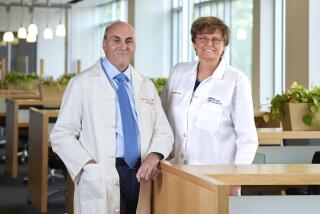Biologist at UCLA Wins Medal : Research: National Science Foundation award goes to Elizabeth Neufeld for her work on two genetic diseases.
- Share via
Molecular biologist Elizabeth Neufeld of UCLA is one of eight U.S. researchers to win this year’s National Medal of Science, the highest award for scientific achievement bestowed by the federal government, the National Science Foundation announced Thursday.
Neufeld was cited in particular for her research on Hurler and Sanfilippo syndromes, two genetic diseases. Her work has led to tests for the diagnosis of the two disorders and has laid the groundwork for the development of new therapies.
Neufeld will receive the award from President Clinton at a White House ceremony in October. There is one other California recipient, structural engineer Ray Clough, retired from UC Berkeley. He developed methods to design large buildings and bridges that can more easily withstand earthquakes.
Neufeld said that her selection “is an enormous honor. I cannot describe how touched I am to have been selected. . . . In a way, I feel like I am accepting it on behalf of all the people who have worked with me.”
Neufeld was a plant biologist when she started her career more than 30 years ago. Her current interest began when “somebody wandered into my lab one day and began telling me about a patient” with one of the syndromes. “I was working in an area that was somewhat related biochemically, but in plants, not in people.
“I had an idea what the problem might be,” she continued. “As it turned out, I was totally wrong, but by the time I had proved that, I was totally hooked.”
Hurler and Sanfilippo syndromes, along with the much better known Tay-Sachs disease, are part of a family of genetic disorders called mucopolysaccharidoses. The diseases, which typically cause fatal neurological deterioration in children, are disorders of liposomes, which Neufeld calls “the recycling plants of the cells. They take large molecules that the cells are through with and break them down into their constituent parts, which can be reused.”
In the syndromes, one or more of the enzymes that are normally used to break the materials down is absent or defective “and the material piles up in the cell,” distorting its shape and putting pressure on nearby tissues, such as nerves. Nerve cells can be killed by the internal pressures within the cell.
When Neufeld started studying Hurler and Sanfilippo syndromes, the working hypothesis was that the cells simply made too much of the accumulated materials. She was able, in her words, “to sort them out” to demonstrate what really was happening and identify the defective gene.
Her discoveries have already led to prenatal diagnosis of affected fetuses and better treatment for the patients and has paved the way for future genetic therapy.
Neufeld’s “excellence in research and teaching are underscored by her contributions educating and counseling families of children affected by the conditions she is working to cure,” said Dr. Sidney Golub, provost of the UCLA School of Medicine. “She is truly a role model for other scientists and physicians.”






